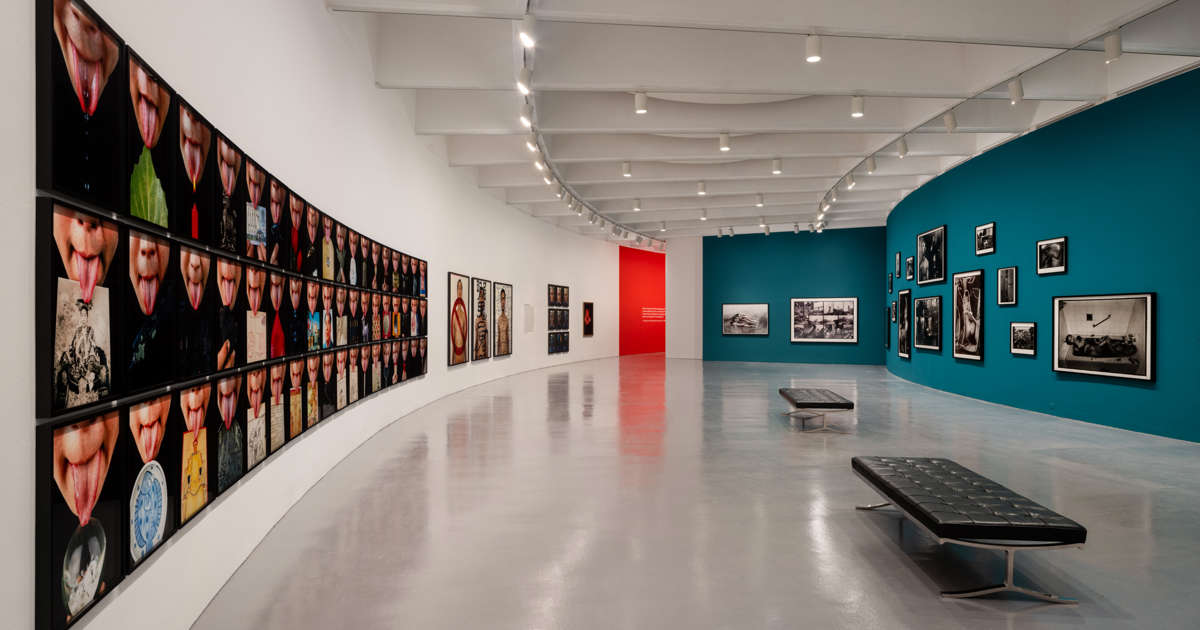[ad_1]
“A Window Suddenly Opens: Contemporary Photography in China,” at the Hirshhorn Museum and Sculpture Garden, features 186 photographs and related artworks. (Ron Blunt/Hirshhorn Museum and Sculpture Garden)
Urgent and edgy, “A Window Suddenly Opens: Contemporary Photography in China” fills most of the Hirshhorn Museum and Sculpture Garden’s second floor. With a spread like that, no single piece could possibly encapsulate the whole exhibition. Yet Sheng Qi’s “My Left Hand (Mother)” is exemplary of this show, featuring 186 photos and related artworks.
The color picture depicts the artist’s hand, missing its little finger and holding in its palm a small black-and-white photo of his mother. Before fleeing Beijing after the 1989 massacre of protesters in Tiananmen Square, Sheng cut off the now-missing finger and buried it in a flowerpot he left behind. The photograph thus combines many attributes common to the exhibition’s works: It’s both conceptual and personal, was made in the spirit of protest, reflects family as well as national history, and documents a bodily performance.
Huang Yan’s “Chinese Landscape Series No. 3.” (Huang Yan)
Although Sheng’s photo stands alone here, it is in fact part of a series. That’s also typical of this show, whose artists often present repeated linked images. The massive piece that greets visitors as they step off the escalator is Song Dong’s “Stamping the River,” a set of 36 vertical pictures in which the artist repeatedly pressed a large wooden seal into Tibet’s Lhasa River to no effect. All that endures are the images documenting the action — and the sense of futility.
“A Window Suddenly Opens” contains work made between 1993 and 2022 but takes its impetus from the first of those three decades. That’s the period of the short-lived East Village, an artist’s colony that occupied an area of cheap migrant-worker housing on the outskirts of Beijing. A few years later came the brief run of New Photo, a magazine whose editorial statement in favor of conceptual photography is the source of the show’s title. One of the publication’s founders was Rong Rong, whose photos of East Village performances fill a large expanse of wall.
A photograph by Rong Rong, “East Village, Beijing,” documenting a 1994 performance, “Twelve Square Meters” by Zhang Huan. (Rong Rong)
The show comes entirely from the holdings of New York collector Larry Warsh, and 141 of the pieces have been promised to the Hirshhorn as a gift.
Sheng is not the only artist to include family snapshots in his work. Zhang Huan photographed himself with pictures of relatives in his open mouth and his face covered in foam. (Much like Song Dong’s river gestures, the foam represents ephemerality.) Song Yongping’s “My Parents (Passage 1-8)” traces the couple from vigorous youth during the Cultural Revolution to existing only as funerary portraits. Wang Jinsong reaches beyond his own clan for “Standard Family,” an array of 200 small and very similar photos. That each features a couple and a single offspring is an implicit critique of China’s one-child policy.
Several pictures employ artists’ bodies as canvases, originally a Western avant-garde idea but with embellishments rooted in Chinese culture. Zhang writes Chinese characters on his face until, over the course of nine photos, his skin becomes entirely black. In a set of four pictures, Huang Yan displays the traditional Chinese landscape his wife painted on his arms and torso. Cang Xin reveals only his tongue in a 54-picture series in which he tastes his roots by licking objects related to Chinese culture.
“Foam 9″ by Zhang Huan. (Zhang Huan)
Wang Qingsong’s “Requesting Buddha Series No. 1.” (Wang Qingsong)
Nudity, a challenge to China’s prescribed propriety, features in many of these photos. Cang’s “To Add One Meter to an Anonymous Mountain” increases the peak’s height with a stack of prone naked bodies. Sixteen black-and-white pictures chart Ma Liuming’s progress as he walks the Great Wall in the nude. There’s also abundant bare skin in the 21st-century work of Wang Qingsong, who uses computer software to stitch photographic images together in horizontal compositions. These emulate traditional Chinese scroll paintings, but with many poses derived from noted European masterworks.
There are a few non-photographic entries by Lin Tianmiao, but they’re all connected to photos. Her three-dimensional fabric pieces follow the outlines of photographs, and her twine-wrapped bicycles appear both as objects and as props in scroll-like photo montages in a format akin to Wang Qingsong’s pictures.
Installation view of “A Window Suddenly Opens,” featuring twine-wrapped bicycles by Lin Tianmiao. (Ron Blunt/Hirshhorn Museum and Sculpture Garden)
Considering how many of the artists produce multiples in sequence, it’s surprising that the show includes only two videos. One is a canine-themed performance piece with office workers in dogface makeup; the other is a computer-generated sci-fi cycle inspired by Buddhist notions of reincarnation.
Most of the show’s participants maintain the traditional idea of a single photograph as a moment of truth, even if that moment is staged rather than serendipitous. But truth is problematic in a totalitarian country that rules by propaganda and indoctrination as well as force. So these artists use subjectivity and theatricality to pry open a window through which viewers can glimpse, however fleetingly, stories that contradict the official narrative.
If you go
A Window Suddenly Opens: Contemporary Photography in China
Hirshhorn Museum and Sculpture Garden, Independence Avenue and Seventh Street SW. hirshhorn.si.edu.
Dates: Through Jan. 7, 2024.
Prices: Free.
[ad_2]






